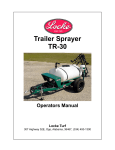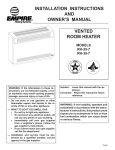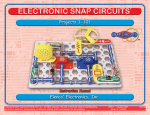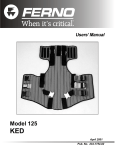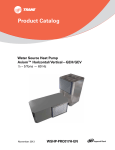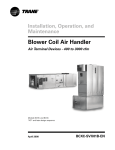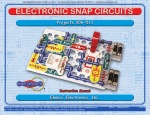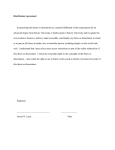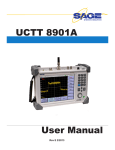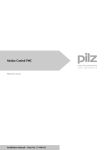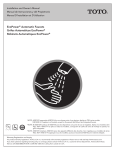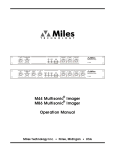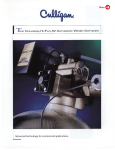Download Trane 120 GEH User's Manual
Transcript
High Efficiency Horizontal and Vertical Water-Source Comfort System AxiomTM 1/2 - 20 Tons - 50 Hz - Vertical (Model GEV) 1/2 - 12-1/2 Tons - 50 Hz - Horizontal (Model GEH) WSHP-PRC003-EN R Introduction Imagine a full range of comfort utilizing efficiency, sound attenuation, integrated controls and superior maintenance accessibility... Trane imagined it, designed it and built it. The AxiomTM line of vertical and horizontal water source heat pumps help create an advanced comfort system for comfort solutions. The entire range of Axiom units - 1/2ton to 20 tons - is designed with the highest standards in mind: Ease of maintenance; Indoor air quality; Quieter operation and higher efficiencies. And, all unit are rated in accordance to ARIISO 13256-1 performance and ASHRAE 90.1 standards. With several size options, the Axiom line of water-source heat pumps is perfect for small to medium sized office Co-axial heat exchanger Thermal expansion valve Fan/Blower section buildings; schools; manufacturing facilities; health care facilities; condominiums and just about any other light commercial application. The following is a list of design improvements contained within all Axiom units: 1 Maximum return/supply air options 6 Integrated controls 7 Dual circuit design 8 High and low pressure safeties in all units 9 Dehumidification options 10 Waterside economizer option 11 Supplimental electric heat options 2 Superior maintenance accessibility 3 Dual-sloped, plastic drain pan 4 Multiple fan speed motor packages 12 Orifice ring motor mounting device on all 5-ton and smaller units 13 Internal air-to-refrigerant coil (1/2-5-ton horizontals) 5 Quieter unit design Integrated controls Model 180 GEV Water Connections Model 120 GEH Dual Compressor 4 & 12 Model 012 GEH 2 WSHP-PRC003-EN R Contents Introduction 2 Model Number Descriptiom 4 General Data 5 Features and Benefits Options 10 Controls 17 Application Considerations 25 Performance Data 29 Electrical Performance 29 Cool and Heat Performance - English 30 Correction Factors - English 72 Cool and Heat Performance - Metric 75 Correction Factors - Metric 117 Fan Performance - English/Metric 120 Sound Data 134 Control Wiring 135 Dimensional Data 143 Accessories 171 Thermostats and Zone Sensors 180 Options 181 Mechanical Specifications WSHP-PRC003-EN 10 185 3 R Model Number Horizontal/Vertical Water-Source Confort System G E H B 036 9 1 D 0 1 1 0 D L D 0 1 0 N 0 0 1 1 0 0 0 1 0 0 0 0 0 0 0 5 10 DIGITS 1-3: UNIT CONFIGURATION GEH = High Efficiency Horizontal GEV = High Efficiency Vertical DIGIT 4: DEVELOPMENT SEQUENCE B DIGITS 5-7: NOMINAL CAPACITY 006 = 1/2 Ton 072 = 6 Ton 009 = 3/4 Ton 090 = 7-1/2 Ton 012 = 1 Ton 120 = 10 Ton 015 = 1 1/4 Ton 150 = 12-1/2 Ton 018 = 1 1/2 Ton 180 = 15 Ton 024 = 2 Ton 240 = 20 Ton 030 = 2 1/2 Ton 036 = 3 Ton 042 = 3 1/2 Ton DIGIT 8: VOLTAGE (Volts/Hz/Phase) 6 = 220-240/50/1 9 = 380-415/50/3 DIGITS 9: HEAT EXCHANGER 1 = Copper-Water Coil 2 = Cupro-Nickel Water Coil DIGIT 10: CURRENT DESIGN SEQUENCE DIGIT 11: REFRIGERATION CIRCUIT 0 = Heating and Cooling Circuit 2 = Heating and Cooling Circuit with Hot Gas Reheat 3 = Heating and Cooling Circuit with Waterside Economizer 4 = Heating and Cooling Circuit with HGR and WSE A = Cooling ONLY Circuit C = Cooling ONLY Circuit with Hot Gas Reheat D = Cooling ONLY Circuit with Waterside Economizer E = Cooling ONLY Circuit with HGR and WSE DIGIT 12: BLOWER CONFIGURATION 1 = Standard Blower Motor 2 = High Static Blower Motor A = Drive Package A (GEH/GEV) B = Drive Package B (GEH/GEV) 4 15 20 C = Drive Package C (GEH/GEV) D = Drive Package D (GEH/GEV) E = Drive Package E (GEH/GEV) F = Drive Package F (GEH/GEV) G = Drive Package G (GEH/GEV) H = Drive Package H (GEH/GEV) J = Drive Package J (GEV) DIGIT 13: CUSTOMER CHANNEL 1 = Boiler/Tower Design for Trane Commercial Group 2 = Geothermal Design for Trane Commercial Group 5 = Trane International Group DIGIT 14: OPEN DIGIT 0 = Standard Design DIGIT 15: SUPPLY-AIR ARRANGEMENT B = Back Supply-Air Arrangement F = Front Supply-Air Arrangement L = Left Supply-Air Arrangement R = Right Supply-Air Arrangement T = Top Supply-Air Arrangement DIGIT 16: RETURN-AIR ARRANGEMENT L = Left Return-Air Arrangement R = Right Return-Air Arrangement B = Back Return-Air Arrangement F = Front Return-Air Arrangement DIGIT 17: CONTROL TYPES 0 = Basic 24 V Controls D = Deluxe 24 V Controls C = Tracer ZN510 Controls B = Tracer ZN524 Controls DIGITS 18: TSTAT/SENSOR LOCATION 0 = Wall Mounted Location DIGITS 19: FAULT SENSORS 0 = No Fault Sensor 1 = Condensate Overflow Sensor 2 = Filter Maintenance Timer 3 = Condensate Overflow and Filter Maitenance Timer 4 = Fan Status Sensor 6 = Condensate Overflow and Fan Status 25 30 H = Fan Status and Filter Maintenance Timer J = Fan Status, Filter Maintenance Timer and Condensate Overflow Sensor DIGITS 20: TEMPERATURE SENSOR 0 = No Additional Temperature Sensor 1 = Entering Water Sensor DIGITS 21: NIGHT SETBACK CONTROL 0 = No Night Setback Relay N = Night Setback Relay DIGITS 22: ELECTRIC HEAT 0 = No Electric Heat 1 = Internal Boilerless Electric Heat DIGITS 23: UNIT MOUNTED DISCONNECT 0 = No Unit Mounted Disconnect DIGITS 24: FILTER TYPE 0 = 1" Filter; No Duct Flange 1 = 1" Throwaway Filter 2 = 2" Throwaway Filter DIGITS 25: ACOUSTIC ARRANGEMENT 0 = Enhanced Sound Attenuation 1 = Deluxe Sound Attenuation DIGITS 26: FACTORY CONFIGURATION 0 = Standard Factory Configuration DIGITS 27: PAINT COLOR 0 = No Paint Selection Available DIGITS 28: OUTSIDE AIR 0 = No Outside Air Option Available DIGITS 29: PIPING ARRANGEMENT 0 = Standard Piping Arrangement 1 = Standard Piping with Schrader Connection for Water Regulating Valve DIGITS 30-36: DOES NOT APPLY TO GEH or GEV WSHP-PRC003-EN R General Data Table G1: General Data - GEH 006 to 018 Model GEH 006 009 012 015 018 Unit Size (in/mm) 40 x 15 x 20 1016 x 381 x 508 40 x 15 x 20 1016 x 381 x 508 40 x 15 x 20 1016 x 381 x 508 46 x 17 x 23 1168 x 432 x 584 46 x 17 x 23 1168 x 432 x 584 Length x Height x Depth Compressor Type Rotary Rotary Rotary Rotary Reciprocating Approx. weight with pallet/without pallet (lbs/kg) 188 / 158 85.3 / 71.7 188 / 158 85.3 / 71.7 188 / 158 85.3 / 71.7 188 / 158 85.3 / 71.7 278 / 248 126.1 / 112.5 Filter Size (nominal in/mm) 14-5/8 x 20-1/4 375 x 517 14-5/8 x 20-1/4 375 x 517 14-5/8 x 20-1/4 375 x 517 14-5/8 x 20-1/4 425 x 603 16-3/8 x 23-5/8 425 x 603 Blower Wheel (in/mm) (Direct Drive) 9x4 229 x 102 9x4 229 x 102 9x4 229 x 102 9x4 229 x 102 9x6 229 x 152 Water in/out (FPT) (in/mm) 1/2 / 12.5 1/2 / 12.5 1/2 / 12.5 1/2 / 12.5 3/4 / 19 Condensate size (NPTI) (in/mm) 3/4 / 19 3/4 / 19 3/4 / 19 3/4 / 19 3/4 / 19 Table G2: General Data - GEH 024 to 048 Model GEH 024 030 036 042 048 Unit Size (in/mm) Length x Height x Depth 46 x 17 x 23 1168 x 381 x 508 46 x 17 x 23 1168 x 381 x 508 50 x 19 x 25 1270 x 483 x 635 50 x 19 x 25 1270 x 483 x 635 58 x 21 x 33 1473 x 533 x 838 Compressor Type Reciprocating Reciprocating Reciprocating Reciprocating Reciprocating Approx. weight with pallet/without pallet (lbs/kg) 278 / 248 126.1 / 112.5 278 / 248 126.1 / 112.5 318 / 288 144.2 / 130.6 318 / 288 144.2 / 130.6 428 / 398 184.1 / 180.5 Filter Size (nominal in/mm) 16-3/8 x 23-5/8 425 x 603 16-3/8 x 23-5/8 425 x 603 18-5/8 x 25-3/8 476 x 647 18-5/8 x 25-3/8 476 x 647 20-5/8 x 29-3/4 524 x 756 Blower Wheel (in/mm) (Direct Drive) 10 x 6 254 x 102 10 x 6 254 x 102 12 x 8 305 x 203 12 x 8 305 x 203 12 x 11 305 x 279 Water in/out (FPT) (in/mm) 3/4 / 19 3/4 / 19 3/4 / 19 1.0 / 25 1.0 / 25 Condensate size (NPTI) (in/mm) 3/4 / 19 3/4 / 19 3/4 / 19 3/4 / 19 3/4 / 19 072 090 120 150 Table G3: General Data - GEH 060 to 150 Model GEH 060 Unit Size (in/mm) Length x Height x Depth 58 x 21 x 33 1473 x 533 x 838 Compressor Type Scroll Reciprocating Reciprocating Scroll Scroll Approx. weight with pallet/without pallet (lbs/kg) 428 / 398 184.1 / 180.5 701 / 652 318.2 / 296 714 / 666 324.1 / 302.3 831 / 798 377 / 362.2 907 / 865 411.7 / 392.7 Filter Size (nominal in/mm) 20-5/8 x 29-3/4 524 x 756 Blower Wheel (in/mm) (Direct Drive) 12 x 11 305 x 279 12.6 x 12.6 321 x 321 12.6 x 12.6 321 x 321 12.6 x 12.6 321 x 321 15 x 15 381 x 381 Water in/out (FPT) (in/mm) 1.0 / 25 1-1/4 / 31.8 1-1/2 / 38.1 1-1/2 / 38.1 1-1/2 / 38.1 Condensate size (NPTI) (in/mm) 3/4 / 19 3/4 / 19 3/4 / 19 3/4 / 19 3/4 / 19 WSHP-PRC003-EN 40-3/4 x 21x 79 40-3/4 x 21x 79 40-3/4 x 21x 79 1035 x 533 x 2006 1035 x 533 x 2006 1035 x 533 x 2006 46-3/4x28x85 1187 x 711 x 2159 19-5/8 x 24-5/8 (x2) 19-5/8 x 24-5/8 (x2) 19-5/8 x 24-5/8 (x2) 24-5/8 x 24-5/8 (x3) 498 x 651 498 x 651 498 x 651 651 x 651 5 R General Data Table G4: General Data - GEV 006 to 018 006 Model GEV Unit Size (in/mm) Length x Height x Depth 009 012 015 018 21-1/2x31-1/4x19-1/5 21-1/2x31-1/4x19-1/5 21-1/2x31-1/4x19-1/5 21-1/2x31-1/4x19-1/5 21-1/2x38-1/4x21-1/2 546 x 793 x 495 546 x 793 x 495 546 x 793 x 495 546 x 793 x 495 546 x 997 x 546 Compressor Type Rotary Rotary Rotary Rotary Reciprocating Approx. weight with pallet/without pallet (lbs/kg) 188 / 158 85 / 71 188 / 158 85 / 71 188 / 158 85 / 71 188 / 158 85 / 71 278 / 248 121 / 112 Filter Size (nominal in/mm) 15-7/8 x 19-7/8 403 x 505 15-7/8 x 19-7/8 403 x 505 15-7/8 x 19-7/8 403 x 505 15-7/8 x 19-7/8 403 x 505 17-7/8 x 24-7/8 454 x 632 Blower Wheel (in/mm) (Direct Drive) 9x4 229 x 102 9x4 229 x 102 9x4 229 x 102 9x4 229 x 102 9x6 229 x 152 Water in/out (FPT) (in/mm) 1/2 / 12.5 1/2 / 12.5 1/2 / 12.5 1/2 / 12.5 3/4 / 19 Condensate size (NPTI) (in/mm) 3/4 / 19 3/4 / 19 3/4 / 19 3/4 / 19 3/4 / 19 030 036 040 Table G5: General Data - GEV 024 to 048 024 Model GEV Unit Size (in/mm) Length x Height x Depth 042 21-1/2x38-1/4x21-1/2 21-1/2x38-1/4x21-1/2 26-1/2x41-7/8x24-1/2 21-1/2x38-1/4x21-1/2 26-1/2x41-7/8x24-1/2 546 x 997 x 546 546 x 997 x 546 673 x 1063 x 622 546 x 997 x 546 673 x 1063 x 622 Compressor Type Reciprocating Reciprocating Reciprocating Reciprocating Reciprocating Approx. weight with pallet/without pallet (lbs/kg) 268 / 248 121 / 112 268 / 248 121 / 112 308 / 288 94 / 131 268 / 248 121 / 112 308 / 288 94 / 131 Filter Size (nominal in/mm) 17-7/8 x 24-7/8 454 x 632 17-7/8 x 24-7/8 454 x 632 19-7/8 x 24-7/8 505 x 632 17-7/8 x 24-7/8 454 x 632 19-7/8 x 24-7/8 505 x 632 Blower Wheel (in/mm) (Direct Drive) 10 x 6 254 x 102 10 x 6 254 x 102 10 x 6 254 x 102 10 x 6 254 x 102 12 x 8 305 x 203 Water in/out (FPT) (in/mm) 3/4 / 19 3/4 / 19 3/4 / 19 3/4 / 19 3/4 / 19 Condensate size (NPTI) (in/mm) 3/4 / 19 3/4 / 19 3/4 / 19 3/4 / 19 3/4 / 19 Table G6: General Data - GEV 048 to 060 6 Model GEV 048 060 Unit Size (in/mm) Length x Height x Depth 30-1/2x46-7/8x26-1/2 774 x 1191 x 673 30-1/2x46-7/8x26-1/2 774 x 1191 x 673 Compressor Type Reciprocating Scroll Approx. weight with pallet/without pallet (lbs/kg) 396 / 348 178 / 158 396 / 348 178 / 158 Filter Size (nominal in/mm) 27-7/8 x 29-7/8 708 x 759 27-7/8 x 29-7/8 708 x 759 Blower Wheel (in/mm) (Direct Drive) 10 x 10 (DD - Std) / 254 x 254 12 x 11 (Hi) / 305 x 279 12 x 11 (Std) / 305 x 279 Water in/out (FPT) (in/mm) 1 / 25 1 / 25 Condensate size (NPTI) (in/mm) 3/4 / 19 3/4 / 19 WSHP-PRC003-EN R General Data Table G7: General Data - GEV 072 to 180 Model GEV 072 090 120 150 180 Unit Size (in/mm) Length x Height x Depth 42 x 62-5/8 x 36-1/4 1067 x 1591 x 921 42 x 62-5/8 x 36-1/4 1067 x 1591 x 921 Compressor Type Reciprocating (2) Reciprocating (2) Scroll (2) Scroll (2) Scroll (2) Approx. weight with pallet/without pallet (lbs/kg) 617 / 577 280 / 262 648 / 608 294 / 276 861 / 821 391 / 373 1215 / 1170 552 / 531 1225 / 1180 556 / 536 Filter Size (nominal in/mm) 19-5/8 x 19-5/8 (4) 498 x 498 (4) 19-5/8 x 19-5/8 (4) 498 x 498 (4) 19-5/8 x 19-5/8 (4) 498 x 498 (4) 19-5/8 x 24-5/8 (6) 498 x 625 (6) 19-5/8 x 24-5/8 (6) 498 x 625 (6) Blower Wheel (in/mm) (Direct Drive) 12.625 x 12.625 321 x 321 12.625 x 12.625 321 x 321 12.625 x 12.625 321 x 321 15 x 15 381 x 381 15 x 15 381 x 381 Water in/out (FPT) (in/mm) 1-1/4 / 32 1-1/4 / 32 1-1/2 / 38 1-1/2 / 38 1-1/2 / 38 Condensate size (NPTI) (in/mm) 3/4 / 19 3/4 / 19 3/4 / 19 3/4 / 19 3/4 / 19 42 x 62-5/8 x 36-1/4 81-5/8 x 68 x 36-1/4 81-5/8 x 68 x 36-1/4 1067 x 1591 x 921 2073 x 1727 x 921 2073 x 1727 x 921 Table G8: General Data - GEH 240 Model GEH 240 Unit Size (in/mm) Length x Height x Depth 81-5/8 x 68 x 36-1/4 2073 x 1727 x 921 Compressor Type Scroll (2) Approx. weight with pallet/without pallet (lbs/kg) 1615 / 1580 733 / 717 Filter Size (nominal in/mm) 19-5/8 x 24-5/8 (6) 498 x 625 (6) Blower Wheel (in/mm) (Direct Drive) (Regular / High Static) 15 x 11 (2) / 12.625 x 12.625 (2) 381 x 279 (2) / 321 x 321 (2) Water in/out (FPT) (in/mm) 2 / 51 Condensate size (NPTI) (in/mm) 3/4 / 19 WSHP-PRC003-EN 7 R General Data Air-to-Refrigerant Coils Table G9: GEH/GEV 006 Working Pressure Tubes High Tubes Deep No. of Circuits Finned vol. (in/mm) (H x W x D) Coil Surface Area (Ft2) Fins Per Inch Tube Material Tube OD (in/mm) Wall Thickness Return Bends Table G13: GEV 015, 018, 024, 030 425 14 2 1 14 x 16 x 1.734 356 x 406 x 44 1.56 12 Copper 3/8 / 10 0.014 Copper Table G10: GEH/GEV 009 Working Pressure Tubes High Tubes Deep No. of Circuits Finned vol. (in/mm) (h,w,d) Coil Surface Area (Ft2) Fins Per Inch Tube Material Tube OD (in/mm) Wall Thickness Return Bends Finned vol. (in/mm) (h,w,d) Coil Surface Area (Ft2) Fins Per Inch Tube Material Tube OD (in/mm) Wall Thickness Return Bends 8 Working Pressure Tubes High Tubes Deep No. of Circuits Finned vol. (in/mm) (h,w,d) Coil Surface Area (Ft2) Fins Per Inch Tube Material Tube OD (in/mm) Wall Thickness Return Bends 425 18 4 6 18 x 21 x 3.464 457 x 533 x 88 2.63 12 Copper 3/8 / 10 0.014 Copper Table G15: GEH 042, 048 425 14 3 1 14 x 16 x 2.598 356 x 406 x 66 1.56 12 Copper 3/8 / 10 0.014 Copper Table G12: GEH 015, 018, 024 Working Pressure Tubes High Tubes Deep No. of Circuits 425 21 4 4 21 x 16 x 3.464 533 x 406 x 88 2.33 12 Copper 3/8 / 10 0.014 Copper Table G14: GEH/GEV 030, 036 425 14 3 2 14 x 16 x 2.598 356 x 406 x 66 1.56 12 Copper 3/8 / 10 0.014 Copper Table G11: GEH/GEV 012 Working Pressure Tubes High Tubes Deep No. of Circuits Finned vol. (in/mm) (h,w,d) Coil Surface Area (Ft2) Fins Per Inch Tube Material Tube OD (in/mm) Wall Thickness Return Bends Working Pressure Tubes High Tubes Deep No. of Circuits Finned vol. (in/mm) (h,w,d) Coil Surface Area (Ft2) Fins Per Inch Tube Material Tube OD (in/mm) Wall Thickness Return Bends Working Pressure Tubes High Tubes Deep No. of Circuits Finned vol. (in/mm) (h,w,d) Coil Surface Area (Ft2) Fins Per Inch Tube Material Tube OD (in/mm) Wall Thickness Return Bends 425 20 4 8 20 x 29 x 3.464 508 x 737 x 88 4.03 12 Copper 3/8 / 10 0.014 Copper Table G16: GEV 042, 048 425 16 4 4 Working Pressure Tubes High Tubes Deep No. of Circuits 16 x 19 x 3.464 406 x 483 x 88 Finned vol. (h,w,d) 2.11 12 Copper 3/8 / 10 0.014 Copper Coil Surface Area (Ft2) Fins Per Inch Tube Material Tube OD (in/mm) Wall Thickness Return Bends 425 24 4 8 24 x 25 x 3.464 610 x 635 x 88 4.17 12 Copper 3/8 / 10 0.014 Copper WSHP-PRC003-EN R General Data Air-to-Refrigerant Coils Table G17: GEH/GEV 060 (2-compr. circuit) Table G20: GEH/GEV 120 (2-compr. circuit) Working Pressure Tubes High Tubes Deep No. of Circuits Finned vol. (in/mm) (h,w,d) Working Pressure Tubes High Tubes Deep Coil Surface Area (Ft2) Fins Per Inch Tube Material Tube OD (in/mm) Wall Thickness Return Bends 425 18 (GEH)/ 24 (GEV) 4 6 refrig flow paths (2X) 18 x 48 x 3.464 / 457 x 1219 x 88 (GEH) 24 x 34 x 3.464 / 609 x 864 x 88 (GEV) 6.00 (GEH) 5.67 (GEV) 14 Copper 3/8 / 10 0.014 Copper No. of Circuits Finned vol. (in/mm) (h,w,d) Coil Surface Area (Ft2) Fins Per Inch Tube Material Tube OD (in/mm) Wall Thickness Return Bends 425 24 (GEH) / 28 (GEV) 4 (GEH) / 2 (GEV) 8 refrig flow paths-2X (GEH) 7 refrig flow paths-2X (GEV) 24 x 73 x 3.464 / 609 x 1854 x 88 (GEH) 28 x 73 x 1.734 / 711 x 1854 x 44 (GEV) 12.167 (GEH) / 14.19 (GEV) 14 Copper 3/8 / 10 0.014 Copper Table G18: GEH/GEV 072 (2-compr. circuit) Table G21: GEH/GEV 150/180 (2-compr. circuit) Working Pressure Working Pressure Tubes High Tubes Deep Tubes High Tubes Deep No. of Circuits Finned vol. (in/mm) (h,w,d) Coil Surface Area (Ft2) Fins Per Inch Tube Material Tube OD (in/mm) Wall Thickness Return Bends 425 18 (GEH)/ 28 (GEV) 4 6 refrig flow paths-2X (GEH) 7 refrig flow paths-2X (GEV) 18 x 54 x 3.464 / 457 x 1372 x 88 (GEH) 28 x 34 x 3.464 / 711 x 864 x 88 (GEV) 6.75 (GEH) / 6.61 (GEV) 14 Copper 3/8 / 10 0.014 Copper No. of Circuits Finned vol. (in/mm) (h,w,d) Coil Surface Area (Ft2) Fins Per Inch Tube Material Tube OD (in/mm) Wall Thickness Return Bends 425 24 (GEH) / 32 (GEV) 4 (GEH) / 3 (GEV) 8 refrig flow paths-2X (GEH) 9 refrig flow paths-2X (GEV) 24 x 73 x 3.464 / 609 x 1854 x 88 (GEH) 32 x 73 x 2.598 / 813 x 1854 x 66 (GEV) 12.167 (GEH) / 16.22 (GEV) 14 Copper 3/8 / 10 0.014 Copper Table G19: GEH/GEV 090 (2-compr. circuit) Table G22: GEV 240 (2-compr. circuit) Working Pressure 425 Working Pressure 425 Tubes High 18 (GEH) / 36 (GEV) Tubes High 36 Tubes Deep 4 Tubes Deep No. of Circuits Finned vol. (in/mm) (h,w,d) Coil Surface Area (Ft2) 9 refrig flow paths (2X) 18 x 73 x 3.464 / 457 x 1854 x 88 (GEH) 36 x 34 x 3.464 / 914 x 864 x 88 (GEV) 9.125 (GEH) / 8.50 (GEV) No. of Circuits Finned vol. (in/mm) (h,w,d) Coil Surface Area (Ft2) 4 18 refrig flow paths (2X) 36 x 73 x 3.464 914 x 1854 x 88 18.25 14 Fins Per Inch 14 Tube Material Copper Tube Material Copper Tube OD (in/mm) 3/8 / 10 Tube OD (in/mm) 3/8 / 10 Fins Per Inch Wall Thickness 0.014 Wall Thickness 0.014 Return Bends Copper Return Bends Copper WSHP-PRC003-EN 9 R Features and Benefits Design Advantages The horizontal and vertical configuratios range in capacities from 1/2 to 5 tons. The innovative designs offers superior field flexibility at the jobsite along with service accessibility. ment may be field converted through a service kit to aid in stocking of a single unit variation. See Figure 2 for component platform location. GEH 1/2 to 5-Ton Cabinet The GEH cabinet design includes a modular platform that utilizes similar parts and assemblies throughout the product line. It is constructed of heavy gauge (non-painted) galvanized metal for maximum durability and corrosive resistive exterior. The cabinet front allows service access for the controls and refrigeration circuitry. Water-in/out connection and high/low voltage hook-up is accomplished at the 45-degree corners on the front-side of the equipment. Figure 1: GEH Component platform location The unit offers six product variations of return-air and supply-air combinations which may be order-specific or job-site modified. See Figure 1 component platform location. GEV 1/2 to 5-Ton Cabinet The vertical design, model GEV includes a modular platform utilizing similar parts and assemblies to the horizontal to provide a repetitious look and feel for installation and maintenance personnel. It is constructed of heavy gauge (non-painted) galvanized metal for maximum durability and corrosive resistive exterior. The cabinet front allows service access for the controls and refrigeration circuitry. Water-in/out connection, drain connection, and high/low voltage hookup is accomplished at the 45-degree chamfered corners on the front-side of the equipment. The vertical design offers four product variations of returnair and supply-air combinations. The GEV model’s supply air arrange- 10 Figure 2: Component platform location Figure 3 Large ton GEH air side combinations. WSHP-PRC003-EN R Features and Benefits GEH/GEV 6 to 20-Ton Cabinet The GEV model is also capable of onsite modifications. With the vertical configuration, the supply-air is easily converted from a top supply-air to a back supply-air with a service retrofit kit. The return-air option is order specific. There are four combinations. See Figure 5 for the four GEV supply/reutm air options. The cabinet design incorporates sturdy (non painted) galvanized metal form maximum durability and corrosive resistive exterior. The equipment offers superior installation flexibility with service accessibility. The cabinet front allows service access for the controls. The new horizontal and vertical design offers four product variations of return-air and supply-air combinations. All combinations are order specific and may not be modified at the job site. See Figure 3 for air side combinations. Hanging the horizontal configuration is accomplished through the robust metal stiffeners located beneath the unit. Optional vibration isolators are available to help decrease sound vibration during equipment operation. Airflow Options: 1/2 to 5 ton The GEH model configuration may be built to order or modified on-site to meet unique installation requirements. The six combinations include sameside supply and return air capabilities for added installation flexibility. See Figure 4 for the six field convertible combinations. Airflow Options: 6 to 20-ton The 6 through 12-1/2-ton horizontal’s airflow flexibility includes four combinations to aid in applications where the equipment is required to hug a corridor or wall. See Figure 3 for the four vertical configurations (previous page). Figure 5: Four GEV airflow combinations The sleek, narrow cabinet of the 6 to 20-ton vertical is designed to fit through a standard doorway for installation during new or retrofit construction.The equipment is available in four supplyair/return-air combinations. These combinations are order specific via the unit model number. See Figure 6 for the four vertidcal airflowvcombinations. Figure 6: Four large-ton GEV airflow combinations Unit Front Unit Front Unit Front Unit Front Unit Front Unit Front Figure 4: Six field convertible GEH airflow combinations Supply Air Return Air WSHP-PRC003-EN 11 R Features and Benefits Hanging Device: 1/2 to 5-ton Drain Pan The hanging bracket resides in the chamfered corner of the horizontal 1/2 to 5 ton equipment. This partially-concealed bracket design eliminates added height, width, or length to the product. The brackets are factory mounted to shorten job installation requirements. The unit drain pan is composed of plastic, corrosive resistive material. The pan is positively sloped to comply with ASHRAE 62 for (IAQ) indoor air quality conformity. See Figure 9 to view the plastic drain pan. Cabinet Insulation The structural integrity of the design helps assure no bracket deflection or unit bowing from the unit’s weight. Field return-air hook-up and filter maintenance are more simplistic. Isolation for the hanging bracket is provided with a neoprene rubber grommet design. This isolation device helps prevent sound vibration from reaching the structural support members of the building during compressor start and stop. See Figure 7 for isolation device. Hanging Device: 6 to 12-1/2-ton The hanging channel for the horizontal unit runs the length of the equipment. The structural integrity of the design helps assure no bracket deflection or unit bowing from the unit’s weight. Optional isolation for the hanging bracket is provided with a itrile rubber grommet design. This isolation device helps prevent sound vibration from reaching the structural support members of the building during compressor start and stop. Access Panels: 12-1/2 to 20-ton The upper panels of the 12 1/2 through 20-ton verticals feature a key hole hanging design for ease of maintenance of the unit, allowing the panel to be hooked into place when attaching the panel to the unit. The panels are also sealed with a rubber gasket at all four edges to help eliminate air from escaping around the panel’s edge. See Figure 8 for GEV panel design. All model cabinet insulation design meets UL 181 requirements. The air stream surface of the insulation is fabricated of a non-biodegradable source. Figure 7: Hanging bracket design Refrigeration Piping The unit’s copper tubing is created from a 99% pure copper formation that conforms to the American Society of Testing (ASTM) B743 for seamless, lightannealed processing. The unit’s copper refrigeration system is designed to be free from contaminants and conditions such as drilling fragments, dirt, or oil. This excludes the possibility of these contaminants from damaging the compressor motor. Figure 8: Large ton GEV panel design Compressor: 1/2 to 5-ton The unit’s design includes a wide variety of compressor motors to accommodate dedicated voltages and tonnage sizes. For more details, See General Data Tables, pages 5-7. Figure 9: Plastic drain pan Figure 10: Reciprocating compressor 12 WSHP-PRC003-EN R Features and Benefits Schrader Connections: 1/2 to 5-ton The connections for the low and high side of the refrigeration system are located directly beside the control box at the front, service access panel. See Figure 11 for schrader connection lotion. Co-axial Water-to-Refrigerant Coil Figure 11: Schrader connections Figure 12: Water connections - small ton The unit’s internal heat exchanging water coil is engineered for maximum heat transfer. The copper or cupro-nickel seamless tubing is a tube within a tube design. The inner-water tube contains a deep fluted curve to enhance heat transfer and minimize fouling and scaling. It is available in either copper or cupro-nickel (selectable option) coil.The outer refrigerant gas tube is made from steel material. The coil is leak tested to assure there is no cross leakage between the water tube and the refrigerant gas (steel tube) coil. Co-axial heat exchangers are more tolerant to freeze rupture. See Figure 11 for co-axial water coil. Compressor and Co-axial Coil Isolation: 1/2 to 5 ton Figure 13: Water connections - large ton Vibration isolation of the compressor and co-axial water coil is accomplished by increasing the rigidity and stiffness at the base. The platform provides double isolation to the compressor and single isolation to the co-axial water coil for additional attenuation during compressor start and stop. Water Connections: 1/2 to 5-ton The water-in/water-out connections to the co-axial water coil are located on the right-hand chamfered corner of the unit. The fittings are mounted flush to the chamfered wall to help limit shipping damage. Figure 14: Thermal expansion valve WSHP-PRC003-EN The water connection devices are constructed of copper or bronze material and include a National Female Pipe Thread (NFPT) junction. The connections are attached to the unit’s chamfer corner to alleviate the need for a back-up wrench during installation. See Figure 12 for water connection device. Water Connections: 6 to 20-ton Water hookups for the 6 through 20 ton units are located internal to the equipment to help alleviate damage to the water copper during shipment or job storage of units prior to installation. Each unit (although dual circuited) contains a single supply and return water connection. See Figure 13 for large tonnage water hook-up, model GEV. Fittings for the supply and return are internally threaded. Expansion Valve All Trane water-source systems include an expansion valve flow metering device. This thermal expansion valve (TXV) allows the unit to operate with an entering fluid temperature from 25 F (3.9 C) to 110 F (43 C), and entering air temperatures from 40 F (4.4 C) to 90 F (32 C). The valve is designed to meter refrigerant flow through the circuitry to achieve desired heating or cooling. The expansion valve device allows the exact amount of refrigerant required to meet the coil load demands. This precise metering by the TXV increases the efficiency of the unit. Reversing Valve A system reversing valve (4-way valve) is included with all heating/cooling units. This valve is piped to be energized in the cooling mode to allow the system to provide heat if valve failure were to occur. Once the valve is energized for cooling, it will remain energized until the control system is turned to the OFF position, or a heating cycle is initiated. Units with the cooling only option will not receive a reversing valve. 13 R Features and Benefits Blower Motor: 1/2 to 5 ton The supply-air (blower) motor is a multi-speed motor with internal thermal overload protection. The motor bearings are permanently lubricated and sealed. Access to the 6 through 25 ton units is made through the back of unit by way of two panels, and/or through a side access panel if adjustment to the motor belt or motor base are needed. Blower Housing All motors are factory wired to the option selected. A high, medium, and low speed tap is provided for field customization on most voltages. The speed tap modification can be made in the control box of the unit. See Figure 15 for blower motor. Note: The three-phase designs are provided in a dual or three-speed version only. See fan performance section for factory ratings. Serviceability to the motor is made through either of the two air-side access doors for the horizontal configuration, and through one air-side access door on vertical configuration. The motor and blower wheel are removable by an orifice ring mounted to the fan housing. Blower Motor: 6 to 20 ton A belt driven motor selection powers the fan for the 6 through 20 ton dual circuit units. The 6 through 12-1/2 ton units include a single fan assembly. The 15 and 20-ton units include dual fan assemblies. Because the motor sheave and the motor base are adjustable in the field, a greater variation in external static pressures are available. The large tonnage units are capable of providing 0 ESP to 3.0 ESP allowing a higher static ductwork to be applied on the mechanical system when the application requires extensive ductwork design. This is a low cost alternative to purchasing, installing, and maintaining multiple smaller tonnage units to meet the required air flow demand for the space. 14 The blower housing is constructed of non-corrosive galvanized steel. A factory-mounted orifice ring is provided for ease of motor serviceability on the 1/2 through 5-ton direct drive units. All air-side panels are interchangeable with one another for ease of field convertibility of the supply-air on the GEH model. Figure 15: 1/2 to 5-ton blower motor Air-Side Filter The air-side filter incorporates severalfiberglass options. These filters include an average synthetic dust weight arrestance of approximately 75%. This dust holding capability includes a colorless, odorless adhesive to retain dirt particles within the filter media after fiber contact. Figure 16: 6 to 20-ton blower motor and fan belt assembly. Air-to-Refrigerant Coil The air-to-refrigerant heat exchanger is constructed of staggered copper tubes with die-formed corrugated lanced aluminum fins. The fins are then mechanically bonded to the tubes through expansion. The coil is placed internal of the unit design for the GEH model to provides an optional dual filtration application. With dual filtration to the GEH unit, maintenance to the filter is significantly less than with a single filtration system. This design also offers maximum flexiblity of the supply and return air configurations. The maximum working pressure for both the GEH and GEV coils is 450 psig. It is designed for maximum capacity with an additional benefit of physical unit size reduction. WSHP-PRC003-EN R Features and Benefits Boilerless Control/Electric Heat (option) The boilerless electric heat option is composed of a nichrome open wire design. This single stage of electric heat is used as a primary heating package to lock out compressor operation in the event that entering-water temperatures reach below 58 F (14.4 C). On a call for heating, the electric heater is activated, locking out the compressor. Once the entering water temperature rises, above 58 F (14.4 C), the unit resumes normal compressor heating operation. For geothermal applications, the boilerless controller is adjustable. The ranges are 25, 35, 45, 55, and 60-degrees F (-3 .9 , 1.7, 7.2, 12.8 , 15.6 C). Trane factory sets the controller to 55-degrees F prior to shipment. See Figure 17 for boilerless control/electric heat diagram. Waterside Economizer (option) The beauty of the waterside economizer is it’s ability to take advantage of any loop condition that results in cool water temperatures. A prime example would be during fall, winter and spring when cooling towers have more capacity than required and could be controlled to lower temperatures for economizer support. Another more common inexpensive means of free comfort cooling includes buildings systems where perimeter heating and core cooling are needed. In this system, the perimeter units extract heat from the building loop while in the heating mode, forcing the building loop temperature to drop. Where as, the core are of a building may require cooling in summer or in winter based upon lighting, people and equipment. WSHP-PRC003-EN Figure 17: Boilerless control/electric heat diagram If the water-source system design contained an economizing coil option, the moderate temperature loop water circulated through a core water-source system can provide an inexpensive means to satisfy room comfort without operating the water-source heat pump’s compressor. During economizer mode, fluid enters the unit, and passes by a water temperature sensing bulb. This temperature sensing bulb deterFigure 18: Model GEH with Waterside Economizer mines whether the two posipackage tion, three-way valve will direct the water through the Mechanical cooling will continue on a waterside economizing coil, and to the call for second stage from the thermoheat pump condenser, or through the stat. The factory built waterside econocondenser only. If the water temperamizer is available on all 1/2 to 5 ton ture is 55 F or less, fluid will flow into GEH models.The 1/2 through 5-ton GEV the economizing coil, while simultanemay be ordered to accept a field proously halting mechanical operation of vided waterside economizing package. the compressor. See Figure 18: Model GEH with Waterside Economizer package. 15 R Features and Benefits Hot Gas Reheat (option) Proper Hot Gas Design For space conditioning and climate control, Trane provides an accurate and cost effective dehumidification control through a hot gas reheat option. This option is designed to accommodate unit sizes 012, 036, 060 and 072 through 240. The factory installed hot gas reheat option is only available with Deluxe or ZN524 controls packages. With this reheat option, the return air from the space is conditioned by the air-to-refrigerant coil, then reheated by the reheat coil to control not only the space temperature, but to also reduce the relative humidity of the space. The moisture removal capability of a specific heat pump is determined by the units latent capacity rating. When operating in the reheat mode (meaning the sensible temperature has been met in the space), the humidistat signals the reheat relay coil to energize, allowing the high pressure refrigerant gas to flow from the (1) compressor, through the (2) reheat valve, into the (3) reversing valve, or through the (4) reheat coil for dehumidification (See Figure 19). A switching relay has been provided for the reheat application to adjust the blower motor from normal operation to low speed when hot gas reheat is energized. Note: Trane places an air separation space between the air-to-refrigerant coil, and the reheat coil to allow for maximum moisture removal. A high static blower motor option will be required to support the hot gas reheat option for the 1/2 through 5 ton equipment. Water regulating valves should not be used with the hot gas reheat option. Trane places a thermal expansion valve on all water-source heat pumps, as well as ground-source heat pumps, to regulate refrigerant flow vs. water flow, making the heat pump more efficient to run. Water-source heat pumps with hot gas reheat should not be used as a makeup air unit. Common Reheat Applications The hot gas reheat option is designed to support building applications requiring fresh-air ventilation units delivering unconditioned-air directly to the space. It also provides dehumidification to large latent load spaces such as auditoriums, theaters and classrooms, or anywhere humidity control is a problem. Figure 19: Hot gas reheat heat pump option. 16 WSHP-PRC003-EN R Features and Benefits Controls Controls by Trane Whether involved in a retrofit or new construction application, Trane has the control design to fit your system requirement. Our control options provide a broad range of packages from the most cost efficient 24 volt standalone to a complete building automation solution, Trane is the right choice in comfort gratification. The following chart provides a brief overview in the different control combinations. Control Basic 24V Graphic Description Compressor lockout relay, low and high pressure switches. Deluxe 24V 24 volt microprocessor designed to provide control of the entire unit, as well as multiple relay offerings to maximize system performance. Can connect to a 24V thermostat. Tracer ZN510TM Direct Digital Control board designed to provide control of the entire unit as well as outputs for unit status and fault detection. Tracer ZN524TM TracerTM Loop Controller TrackerTM Direct Digital Control board designed to provide control of the entire unit as well as outputs for unit status and fault detection. Microprocessor-based controller that coordinates the water side (boiler, pumps, cooling tower, etc.) of a watersource heat pump system. Microprocessor-based controller that coordinates boiler, pumps, cooling tower, etc. of a water-source heat pump system. Customized alarms, scheduling, trending, safety features. Controls up to 100 wshp’s. Tracer Summit® WSHP-PRC003-EN Microprocessor based controller that coordinates full building automation from HVAC to lighting. Application ICS Protocol No NonApplicable No NonApplicable Yes SCC LonTalk® open protocal (Comm 5) Yes SCC LonTalk® open protocal (Comm 5) Yes LonTalk compatible (Comm 5) Yes LonTalk compatible (Comm 5) Yes BACnet (Comm 2, 3, 4, & 5) Retrofit market where single and multiple unit replacement occurs. New building design where field provided controls are specified. Retrofit market where single and multiple unit replacement occurs. Multi-unit installation where units may be daisy- chained directly to the Trane TracerTM Loop Controller. Retrofit market where overall system upgrade is specified. Multi-unit (100+) installation where units are linked by a common twisted pair of wire for a communication link. Retrofit market where overall system upgrade is specified. Multi-unit (100+) installation where units are linked by a common twisted pair of wire for a communication link. Wherever the Tracer ZN510 controls or 24 volt electro-mechanical controls are specified for complete control of the water loop and pumps. Wherever the Tracer ZN510 controls or 24 volt electro-mechanical controls are specified for complete control of the water loop and pumps. New and retro fit light commercial applications. Where any controller is specified. 17 R Features and Benefits Basic Controls Basic 24 Volt Controls The basic 24 V electromechanical unit control provides component protection devices for maximum system reliability. Each device is factory mounted, wired and tested. See Figure 20 for the unit control box. excessive discharge pressures that exceed 395 psig. A lockout relay provides the mechanical communication of the low and high pressure switches to prevent compressor operation if the unit is under low or high refrigerant circuit pressure, or during a condensate overflow condition. The lockout relay may be reset at the thermostat, or by cycling power to the unit. General alarm is accomplished through the lockout relay and is used in driving light emitting diodes. This feature will drive dry contacts only, and cannot be used to drive field installed control inputs. See Figure 21 for unit safety devices on the basic 24V control unit. Figure 20: Basic 24-volt control box. Stand-alone System Figure 21: BAsic 24-volt safety devices. Safety Devices System safety devices are provided through the use of low/high pressure switches in the refrigeration circuit to help prevent compressor damage. The switch and sensor are set to activate at refrigerant pressures of 20 psig to fit most applications. Figure 22: 24-volt stand-alone system. In cases where a low charge, or excessive loss of charge occurs, each compressor comes equipped with an external overload device to halt the compressor operation. The high pressure switch prevents compressor operation during high or 18 The 24 volt electro-mechanical design may be applied as a stand-alone control system. The stand-alone design provides accurate temperature control directly through a wall-mounted mercury bulb or electronic thermostat. This system set-up may be utilized in a replacement design where a single unit retrofit is needed. It may be easily interfaced with a field provided control system by way of the factory installed 18pole terminal strip. This stand-alone control is frequently utilized on small jobs where a building controller may not be necessary, or where field installed direct digital controls are specified. This type of control design does require a constant flow of water to the water source heat pump. With a positive way to sense flow to the unit, the units safety devices will trigger the unit off. The stand-alone system design provides a low cost option of installation while still allowing room control for each unit. See Figure 22 for 24 volt stand-alone system controls. WSHP-PRC003-EN R Features and Benefits Deluxe Controls Deluxe 24V Electronic Controls The deluxe 24V electronic unit control provides component protection devices similar to the basic design, but contains upgraded features to maximize system performance to extend the system life. Each device, is factory mounted, wired, and tested in the unit. See Figure 23 for unit control box. Small Building Control The deluxe 24V electro-mechanical design may be applied as a stand-alone control system or as a multi-unit installation system. With a stand-alone design, units run independently of one another with a mercury bulb or electronic digital thermostat. With a multiple unit installation, the units may be daisy-chained directly to the Trane Tracer loop controller (TLC), pump(s), boiler, and tower for a complete networked water-source system. The TLC provides a night setback output, and a pump request input for system optimization.See Figure 24 for 24volt deluxe control system. Figure 23: Deluxe 24V control box. Figure 24: 24-volt deluxe control system. WSHP-PRC003-EN 19 R Features and Benefits Deluxe Controls Microprocessor Design The 24 volt deluxe design is a microprocessor-based control board conveniently located in the control box. The board is unique to Trane water-source products and is designed to control the unit as well as provide outputs for unit status and fault detection. The Trane microprocessor board is factory wired to a terminal strip to provide all necessary terminals for field connections. See Figure 27 for the deluxe 24V control board. Deluxe 24V features include: Random Start The random start relay provides a time delay start-up of the compressor when cycling in the occupied mode. A new start delay time between 3 and 10 seconds is applied each time power is enabled to the unit. Anti-short Cycle Timer The anti-short cycle timer provides a three minute time delay between compressor stop and compressor restart. Brown-out Protection The brown-out protection function measures the input voltage to the controller and halts the compressor operation. Once a brown-out situation has occurred, the anti-short cycle timer will become energized. The general fault contact will not be affected by this condition. The voltage will continue to be monitored until the voltage increases. The compressors will be enabled at this time if all start-up time delays have expired, and all safeties have been satisfied. Compressor Disable The compressor disable relay provides a temporary disable in compressor operation. The signal would be provided from a water loop controller in the system. It would disable the compres- 20 sor because of low water flow, peak limiting or if the unit goes into an unoccupied state. Once the compressor has been disabled, the anti-short cycle time period will begin. Once the compressor disable signal is no longer present, and all safeties are satisfied, the control will allow the compressor to restart. Generic Relay The generic relay is provided for field use. Night setback or pump restart are two options that may be wired to the available relay. (Note: Night setback is available as factory wired). An external Class II 24VAC signal will energize the relay coil on terminals R1 and R2. Terminals C (common), NO (normally open), and NC (normally closed) will be provided for the relay contacts. Safety Control The deluxe microprocessor receives separate input signals from the refrigerant high pressure switch, low suction pressure switch and condensate overflow. In a high pressure situation, the compressor contactor is de-energized, which suspends compressor operation. The control will go into soft lockout mode initializing a three minute time delay and a random start of 3 to 10 second time delays. Once these delays have expired, the unit will be allowed to run. If a high pressure situation occurs within one hour of the first situation, the control will be placed into a manual lockout mode, halting compressor operation, and initiating the general alarm. switch is open for 45 seconds during compressor start, the unit will go into soft lockout mode initializing a three minute time delay and a random start of 3 to 10 second time delays. Once these delays have expired, the unit will be allowed to run. If the low pressure situation occurs again within 30 minutes, and the device is open for more than 45 seconds, the control will be placed into a manual lockout mode, halting compressor operation, and initiating the general alarm. In a condensate overflow situation, the control will go into manual lockout mode, halting compressor operation, and initiating the general alarm. The general alarm is initiated when the control goes into a manual lockout mode for either high pressure, low pressure or condensate overflow conditions. Diagnostics Component device connections to the microprocessor board are referenced in Figure 25. Three LEDs (light emitting diodes) are provided for indicating the operating mode of the controller. See the unit IOM for diagnostics or troubleshooting through the use of the LEDs. Figure 25: Deluxe 24V control board. In a low temperature situation, the low pressure switch will transition open after the compressor starts. If the WSHP-PRC003-EN R Features and Benefits ZN510 & ZN524 Controls Tracer ZN510 & ZN524 Controls The Tracer ZN510 and ZN524 are direct digital control (DDC) systems specifically designed for single and dual circuited water-source equipment to provide control of the entire unit, as well as outputs for unit status and fault detection. Each device is factory installed, commissioned, and tested to ensure the highest level of quality in unit design. Each of the controller’s features and options were selected to coordinate with the unit hardware to provide greater energy efficiency and equipment safety to prolong the equipment life. In addition to being factory configured for control of the unit fan, compressor and reversing valve, the ZN510 and ZN524 controllers are designed to coordinate the waterside of the water-source system through the Tracer Loop Controller (TLC). If applied in a peer-to- peer communication environment, data between similar controllers may be exchanged without requiring a building automation system. By teaming the ZN510 and ZN524 with the TLC, a low first-cost for the mechanical equipment, water loop, and water pump optimization is provided to the owner. For owners who require a full building integrated "open protocol" system, The ZN510/ZN524/TLC application is upgradable to support complete building control through Tracer Summit. Because the ZN510 and ZN524 is LonTalk certified, it is capable of working with, and talking to other LonTalk certified controllers providing the building owner more choices, and the design engineers more flexibility to meet the challenges of building automation. See Figure 26 for ZN510 control box. Figure 26: ZN510/ZN524 control box WSHP-PRC003-EN 21 R Features and Benefits ZN510 & ZN524 Controls Direct Digital Controls When the ZN510 or ZN524 controller is linked directly to the Tracer Summit, each Tracer Summit building automation system can connect a maximum of 120 Tracer ZN510 or ZN524 controllers. See Figure 27 for the Tracer ZN524 board. Figure 27: Tracer ZN524 board. Tracer ZN510 and ZN524 functions include: Compressor Operation The compressor is cycled on and off to meet heating or cooling zone demands. Single and dual compressor units use the unit capacity and pulse width modulation (PWM) logic along with minimum on/off timers to determine the compressor’s operation. The compressor is controlled ON for longer periods as capacity increases and shorter periods as capacity decreases. Random Start To prevent all of the units in a building from energizing major loads at the same time, the controller observes a random start from 0 to 25 seconds. This timer halts the controller until the random start time expires. Reversing Valve Operation For cooling, the reversing valve output is energized simultaneously with the compressor. It will remain energized until the controller turns on the compressor for heating. At this time, the reversing valve moves to a de-ener- 22 gized state. In the event of a power failure or controller OFF situation, the reversing valve output will default to the heating (de-energized) state. during daytime hours of temporary low occupancy. To determine the space occupancy, an occupancy sensor is applied. Fan Operation The supply air fan operates at the factory wired speed in the occupied or occupied standby mode. When switch is set to AUTO, the fan is configured for cycling ON with heating or cooling. In heat mode, the fan will run for 30 seconds beyond compressor shutdown in both occupied and unoccupied mode. In an unoccupied situation, the controller assumes the building is vacant, normally during evening hours. In the unoccupied mode, the controller uses the default unoccupied heating and cooling setpoints stored in the controller. When the building is in unoccupied mode, individual units may be manually placed into timed override of the unoccupied mode at the units wall sensor. During timed override, the controller interprets the request and initiates the occupied setpoint operation, then reports the effective occupancy mode as occupied bypass. Fan Run Timer The controller’s filter status is based on the unit fan’s cumulative run hours. The controller compares the fan run time against an adjustable fan run hours limit and recommends unit maintenance as required. Data Sharing The Tracer ZN510/ZN524 controller is capable of sending or receiving data (setpoints, fan request, or space temperature) to and from other controllers on the communication link. This allows multiple units to share a common space temperature sensor in both stand-alone and building automation applications. Night Setback The four operations of the Tracer ZN510/ZN524 controller include occupied, occupied standby, occupied bypass and unoccupied. In an occupied situation, the controller uses occupied heating and cooling setpoints to provide heating and cooling to the building. This occupied operation is normally used during the daytime hours when the building is at the highest occupancy level. In an occupied standby situation, the controllers heating and cooling setpoints are usually wider than the occupied setpoints. This operation is used In the occupied bypass mode, the controller applies the occupied heating and cooling setpoint for a 120 minute time limit. High/Low Pressure Safety Controls The Tracer ZN510/ZN524 controller detects the state of the high pressure or low pressure switches. When a fault is sensed, the corresponding message is sent to the controller to be logged into the fault log. When the circuit returns to normal, the high pressure control and low pressure control automatically reset. If a second fault is detected within a thirty-minute time span, the unit must be manually reset. Condensate Overflow When condensate reaches the trip point, a condensate overflow signal generates a diagnostic which disables the fan, unit water valves (if present), and compressor. The unit remains in a halted state until the condensation returns to a normal level. The switch in the drain pan will then automatically reset. The controller’s condensate overflow diagnostic must be manually reset to clear the diagnostic and restart the unit. WSHP-PRC003-EN R Features and Benefits ZN510 & ZN524 Controls More ZN524 Controller Functions: When the building owners choice is Trane Tracer controls, the ZN524 controller is required when any of the following applications are selected on a single and dual circuited equipment. • Waterside Economizer • Hot Gas Reheat (Dehumidification) • Boilerless Control for Electric Heat • Water Isolation Valve Control (for Variable Speed Pumping) Entering Water Temperature Sampling The ZN524 controller will sample the entering water temperature to determine proper control action for units equipped with boilerless electric heat or waterside economizer. Waterside Economizer Entering water temperature (EWT) sampling will automatically occur at power up when the unit is equipped with a waterside economizer (WSE). The EWT is used to determine if economizing is feasible. When the conditions are met, the isolation valve(s) are driven open for three minutes and the EWT reading is taken. The determination as to whether or not the economizer can be enabled will be made and the controller will take appropriate action. The isolation valve will remain open regardless if the WSE or the DX cooling is enabled. The unit’s waterside economizer will contain a 2-position water valve wired to the ZN524. The economizing water coil will be optimized to provide 100% of the unit capacity at 80.6 F/66.2 F (27.0/10.0 C) return air temperature with 45 F (7 C) entering water. The flow rate is established at 86 F (30 C) entering water temperature and 96 F (36 C) leaving water temperature. WSHP-PRC003-EN Low leaving air protection will be furnished to protect the unit against delivering air that is cold enough to sweat discharge air grilles. Coil icing protection will also be provided. Waterside economizer cooling will be active during occupied, unoccupied and standby cooling modes. Boilerless Control Electric Heat and Supplemental Electric Heat: The ZN524 supports a single stage of boilerless electric heat operation or concurrent heating. When the unit is configured for boilerless control, the EWT will be used to determine whether DX heating should be disabled and the electric heater enabled. When these conditions are met, the isolation valve(s) are driven open for three minutes and the entering water temperature reading is taken. The determination as to whether or not to utilize electric heat will be made and the controller will take appropriate action. If boilerless electric heat is enabled, then the isolation valve will be closed, shutting down the water flow to the unit. When the unit is configured for concurrent operation of DX heating (compressor in heat pump mode) and electric heat, the electric heat will act as a second stage of heat for single compressor units, and a third stage of heat for dual compressor units. Note: With concurrent (or supplemental) electric heat, the electric heater is field provided. are driven open for operation, the outputs will be driven for 20 seconds to ensure adequate water flow before the compressor outputs are energized. Once an isolation valve has been opened, it will remain open for a 10 minute minimum to reduce excessive cycling of the valve. Dehumidification Dehumidification for the single and dual circuited water-source heat pump is applicable with the ZN524 controller. The controller is capable of directing one stage of DX cooling in conjunction with one stage of reheat (hot gas reheat). Dehumidification can only occur when the controller is in the cooling mode. A humidity transmitter is used to measure the zone’s relative humidity (RH), then compares the zone relative humidity to the relative humidity enable/disable setpoint parameters. The default values for dehumidification enable is 60% RH with the disable point at 52% RH. These values are configurable. Water Isolation Valves Variable speed pumping systems are supported by the ZN524 controller when water isolation valves are present. Up to two isolation valves are supported by the controller (one for each compressor circuit). The valves are normally closed unless DX heating, DX cooling, waterside economizer or dehumidification is requested. When the isolation valves 23 R Features and Benefits ZN510 & ZN524 Controls Building Control Advantages The Tracer ZN510/ZN524 controller has the ability to share information with one or several units on the same communication link. This sharing of information is made possibe via a twisted pair of wire and a building automation system or through Trane’s RoverTM service tool . An advantage of installing a ZN510/ZN524 is its capability to work with other LonTalk certified controllers. This provides greater flexibility to the building owner, as well as greater flexibility in design. Integrating the ZN510/ZN524 on watersource equipment, and tying it to a Tracer Summit system provides a complete building management system. Each Tracer Summit can connect to a maximum of 120 controllers. With the ICS system, the Tracer can initiate an alarm on a loss of performance on equipment malfunctions; allowing problems to be handled in a timely manner before compromising comfort. This type of application would most commonly be used for a large space(s) that may require more than one unit. In addition to this application design, the Tracer ZN510/ZN524 controller provides a way for units located within the same space to share the same zone sensor to prevent units from simultaneously heating and cooling in the same space.See Figure 28 for Tracer ZN510/ZN524 controller system. Figure 28: Tracer ZN controller system installation. 24 WSHP-PRC003-EN R Application Considerations Figure 29: Horizontal unit installation 4” 1/ e: op l S .5 (6 ) m m 12”/ 305mm Slope: 1/4” (6.5 mm) Hanging the Horizontal The horizontal unit GEH A is a ceiling hung unit. It is usually applied as a totally concealed unit above an acoustical ceiling grid. Because the GEH A is equipped with several inlet and discharge arrangements, it allows for numerous application needs. When hanging the horizontal design, the unit should be pitched approximately 1/4-inch (6.4 mm) per foot toward the drain in both directions. This aids in condensate removal from the drain pan. (See Figure 29 for unit installation.) Hanging Devices and Duct Attachments Figure 30: Unit duct collar and hanging device installation. All GEHA units are shipped with a factory mounted hanging bracket and rubber isolation grommet. The 3/8 -inch (9.5 mm) all-thread and 3/8 -inch (9.5 mm) washer and nut are field provided. One-inch duct collars are provided for field duct attachment to the supply-air outlet. The duct collars, filter racks, filter and grommets are field installed. These items are shipped in an inclosure external to the unit. (See Figure 30 for unit duct collar and hanging device installation.) WSHP-PRC003-EN 25 R Application Considerations Condensate Traps When designing a condensate trap for the water-source system, it’s important to consider the unit’s draw through design. Under normal conditions, condensate runs down the coil fins and drips into a condensate pan. In situations where no trap is installed, the water level that would be maintained in the trap to create a seal, backflows through the drainline into the unit. Because the fan pulls air through the air-torefrigerant heat-exchanger, this incoming air stream could launch water droplets, forming at the base of the coil, into the air. the mechanical system. This aerosol mist can be carried through the ducts and into the conditioned air space. Another problem with air backflow, is the source of that air. Drain lines typically flow into waste or sewage lines, giving the potential to introduce methane and other contaminants from the drain system into the airstream. In a properly trapped system, when condensate forms during normal operation, the water level in the trap rises until there is a constant outflow. (See Figure 31, for the appropriate dimensions required in designing a negative pressure system.) Air flowing through the coil can then spray condensate into the fan intake, with the possibility of propelling moisture into other parts of Figure 31: Condensate trap installation. 26 WSHP-PRC003-EN R Application Considerations Distributed Pumping System A distributed pumping system contains either a single or dual pump module, specifically sized for each water-source heat pump, then connected directly to the units supply and return lines. The distributed system’s supply and return lines should be sized to handle the required flow with a minimum pressure drop. 1. Hose kits are used to connect the water supply and return line to the water inlets and outlets. Trane offers various hose kit combinations to better facilitate system flow balancing. These flexible hoses also aid in the reduction of vibration between the unit and the rigid central piping system. sized to handle the required flow with a minimum pressure drop. Note: Pipe will sweat if low temperature water is below the dew point of the surrounding space. Trane recommends that these lines be insulated to prevent damage from condensation when condenser loop is designed to be below 60 F/ 16 C. Equipment installed in attic/crawl space temperatures below 40 F/ 4 C may require antifreeze in the water loop. 7. For acoustically sensitive areas, a sixinch deep fiberglass insulation is recommended to be field installed below the horizontal unit. This field supplied insulation should be approximately twice the footprint size of the unit. It provides sound damping of the unit while in operation. Figure 32: Distributed pumping system installation. 2.The unit’s (item 2) 3/4-inch high 3. voltage and (item 3) 1/2-inch low voltage connections are located on the left chamfered corner of the unit. They are designed to accept conduit. 4.A field supplied line voltage disconnect should be installed for branch circuit protection. Check local codes for requirements. 5.Trane’s self-contained pump module and hose kit make a complete pumping package for distributed pumping systems. The module is designed for circulating commercial loops that require a maximum flow rate of 20 gpm (76 lpm). Each pump module is fully assembled for connection to water and electrical points. The kit contains all of the necessary components for the installation, operation and maintenance of a closed loop application. See WSHPC-IN-5 (72-9006-03) for electrical and dimensional requirements 6.The distributed pumping system supply and return lines should be WSHP-PRC003-EN 27 R Application Considerations Installation Made Easy Installing a horizontal unit inside a corridor to enhance sound attenuation provides value to duct design. Trane takes this fact one step further. The new GEH design offers same side return-air/supply-air access to the unit. This access is contained within the overall dimension of the units length as shown in Figure 32. The duct access to the unit allows the unit to be installed closely against a corridor wall, while at the same time eliminating space required for the duct design. Most horizontal unit designs provide an opposite supply air from the return air arrangement, or an end supply arrangement option. See Figure 33 for end-supply example. An end-supply design increases the overall unit length of the system to accommodate a 90-degree duct turn. This not only requires added space, but also adds cost in both materials and installation. Additional value to the design is acquired through the same side supply/return-air design. This design eliminates a requirement for a four sided service access. When installing the same side return/supply-air access, a brief 3-inch minimum is all that is required between the unit and the wall. Service Access To add more value in installation requirements, the same side supply/return design eliminates the need for a four-sided service access (See Figure 34). When installing the same side return/supply access, a small 3” / 76 mm minimum space is required between the unit and wall. Figure 32: Same side supply/return air and end supply arrangements with ductwork. Figure 33: Service access requirments. 28 WSHP-PRC003-EN





























